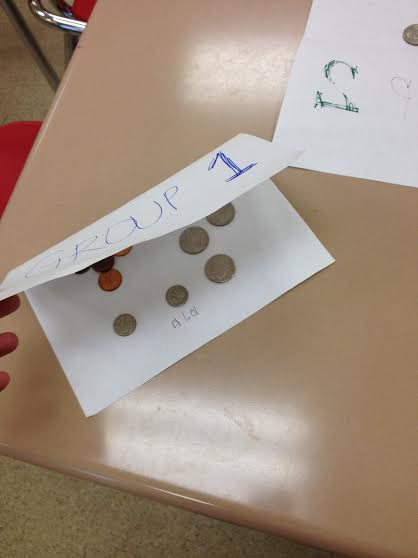Without a moment's delay we were up and running, ready to try all that we learned out on our new students. Below is one example from Mrs. Teichman's 10th grade Algebra 1 class of our progressive and reflective teaching approach. Never one to simply do the same old lesson, Mrs. Teichman created a wonderful opportunity for collaborative work while developing the students' creative side. Here it is in her own words...
Making Algebra More “Valuable”
I am constantly looking to enrich my sophomore Algebra 1 class, yet I was waiting to introduce any enrichment activity until the students first grew accustomed to our classroom routines and procedures. Starting on the first day of school, my students proved themselves to be highly motivated, articulate, and cooperative; no math challenge was too difficult for them to try, no student pairing was unsuccessful. Two weeks in, I was ready to try something different.
Problems with Words (aka “Word Problems”)
Our lesson on Cost, Income, and Value Word Problems was, as I expected, a bit more difficult for many of my students. After modeling several such problems and assigning homework,I thought about the main issue: decoding the mathematical language and expressing it algebraically. I thought, "Wouldn't it be beneficial if my students could first see the scenario and then try to formulate descriptive phrases?", and formed the following lesson.
The Plan
Upon arrival to class, my 18 students would be divided randomly into three groups of six and seat themselves as the three desk clusters that I had made.
Each group would be provided with a piece of lined easel paper, a magic marker, and a pocket with their group name and a series of coins underneath it.

During Round 1, the groups were to write a word problem to describe the amount of coins that they had been given. I encouraged students to use phrases such as “3 times the amount of” “twice as many”, and “4 less than.”
During Round 2, the groups would rotate seats and head to the next table, where they saw a word problem and had to decode the language and arrive at a solution.
During Round 3, the groups would rotate to the third cluster of desks where they saw both the Word Problem and algebraic solution on the easel paper; their job was to check for and correct any errors.
Finally, during Round 4, groups would return to their original clusters and see their classmates’ solutions (and corrections) resulting from their original word problem.
The Outcome
My plan went pretty smoothly, although I had underestimated how much time it would take the groups to accomplish the tasks in rounds 1 and 2. Groups struggled to decide on a word problem whereby one group member came up with a convoluted (and impossible) word problem which his own peers couldn't decipher even with the scenario in front of them. One group arrived at a perfectly solvable word problem, but made careless errors in their solution and therefore could not find an answer. Yet another group had trouble finding the said error,and simply restarted the solution.
When we regrouped as a class, I posted the posters and led a discussion on "what worked and what didn't" and analyzed each of the group's collaborative works.
Reflections
Before we knew it, class was over, the students filed out, and our busy days rushed onward. Later that evening, I was able to reflect on just how powerful this activity had been for my students.
- Strong Command of Mathematical Language - Students were able to recognize the meaning of tricky statements like “There are 4 fewer quarters than there are dimes” when trying to describe their amount of coins.
- Collaboration - This group of sophomores is particularly cooperative in this regard, but the project helped them realize how important it was to communicate and agree when formulating a piece of work.
- Creating a Word Problem - Word Problems are often an Algebra student’s worst nightmare. First seeing a solution and cloaking the answers in creative words helped give an entirely different perspective to the task of solving these problems.
- Pride and Ownership - Having others try to solve their unique creation no doubt gave the students a sense of ownership of the material and pride at creating something mathematically sound. Breathing life into a creative work is an act that colors the English, Creative Writing, and Art classrooms but that, unfortunately, our textbook-based curricula strips from the Math classroom.
I am so proud of my students for their effort and I look forward to continuing to show them how math can be the synthesis of creativity, precision, and collaboration.
-Mrs. Shira Teichman
Math Teacher and Enthusiast The Frisch School
-Mrs. Shira Teichman
Math Teacher and Enthusiast The Frisch School
No comments:
Post a Comment